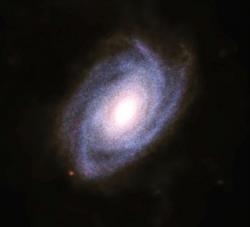- Home
- Department
- Research
- Teaching
- Post Graduate Studies
- Knowledge Transfer
- How To
Galaxy formation
Research Strand:
 Observations of the cosmic microwave background, of distant supernovae, of gravitational lensing and galaxy clusters are now constraining the cosmological model to an unprecedented accuracy, opening the doors to the age of high-precision cosmology. But the formation of galaxies, the first step from the linear and mildly non-linear Universe to the complexity of astrophysical objects, is still an open question. Galaxy formation is indeed driven by the gravitational clustering of the elusive dark matter, but the properties of galaxies are shaped by the retroactive energy exerted by massive dying stars, and especially by exploding supernovae. Moreover, star formation in the most massive galaxies is quenched by energetic feedback from the super-massive black holes that are hosted at their centres.
Observations of the cosmic microwave background, of distant supernovae, of gravitational lensing and galaxy clusters are now constraining the cosmological model to an unprecedented accuracy, opening the doors to the age of high-precision cosmology. But the formation of galaxies, the first step from the linear and mildly non-linear Universe to the complexity of astrophysical objects, is still an open question. Galaxy formation is indeed driven by the gravitational clustering of the elusive dark matter, but the properties of galaxies are shaped by the retroactive energy exerted by massive dying stars, and especially by exploding supernovae. Moreover, star formation in the most massive galaxies is quenched by energetic feedback from the super-massive black holes that are hosted at their centres.
This complexity is addressed either with numerical simulations or with so-called semi-analytic models. Our group has contributed to the field (1) by developing a semi-analytic model of galaxy formation, where the physics of baryons is included in the skeleton of dark matter merger trees through a set of simplified models describing the various processes by which gas is transformed into stars; (2) by developing, within the GADGET Tree-PM+SPH code for simulations of galaxies in a cosmological context, a model for the behaviour of star-forming gas under the effect of energetic feedback from supernovae (see Cosmology page).
Info
Last update: 08-06-2025 - 12:38









